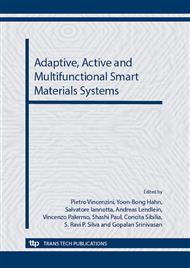[1]
Martijn H. R. Lankhorst, Bas W. S. M. M. Ketelaars & R. A. M. Wolters, Low-cost and nanoscale non-volatile memory concept for future silicon chips, Nature materials, vol. 4, pp.347-352, (2005).
DOI: 10.1038/nmat1350
Google Scholar
[2]
S. Tiwari, F. Rana, H. Hanafi, A. Hartstein & E. F. Crabbe, A silicon nanocrystals based memory, Appl. Phys. Lett., vol. 68, pp.1377-1379, (1996).
DOI: 10.1063/1.116085
Google Scholar
[3]
L. O. Chua, Memristor-The missing circuit element, IEEE Trans. Circuit Theory, vol. 18, p.507–519 (1971).
DOI: 10.1109/tct.1971.1083337
Google Scholar
[4]
J. J. Yang et al, Memristive switching mechanism for metal/oxide/metal nanodevices, Nature Nanotechnol., vol. 3, p.429–433 (2008).
Google Scholar
[5]
Y. Fujisaki, Current Status of Nonvolatile Semiconductor Memory Technology , Jap. J. Appl. Phys. 49 100001 (2010).
DOI: 10.1143/jjap.49.100001
Google Scholar
[6]
R. Waser et al, Redox-Based Resistive Switching Memories –Nanoionic Mechanisms, Prospects, and Challenges, Adv. Mater. 21, 2632 (2009).
DOI: 10.1002/adma.200900375
Google Scholar
[7]
S.S. Nonnenmann, E.M. Gallo and J.E. Spaniera, Redox-based resistive switching in ferroelectric perovskite nanotubes, Appl. Phys. Lett. 97, 102904 (2010).
DOI: 10.1063/1.3486224
Google Scholar
[8]
P.Y. Lai and J.S. Chen, Ultrahigh ON/OFF-Current Ratio for Resistive Memory Devices With Poly(N-Vinylcarbazole) / Poly(3, 4-Ethylenedioxythiophene) – Poly(Styrenesulfonate) Stacking Bilayer, IEEE El. Dev. Lett., 32, 3 (2011).
DOI: 10.1109/led.2010.2099102
Google Scholar
[9]
B. O'Reagan and M. Gratzel A low cost high efficiency solar cell based on dye-sensitized TiO2 colloidal films, Nature 353, 737 (1991).
DOI: 10.1038/353737a0
Google Scholar
[10]
R. Sardar, A. M. Funston, P. Mulvaney, R. W. Murray, Gold Nanoparticles: Past, Present, and Future, Langmuir, 2009, 25 (24), 13840–13851.
DOI: 10.1021/la9019475
Google Scholar
[11]
C. N. Ramachandra Rao, Giridhar U. Kulkarni, P. John Thomasa, Peter P. Edwards, Metal nanoparticles and their assemblies, Chem. Soc. Rev., 2000, 29, 27-35.
Google Scholar
[12]
J. Turkevich, P. C. Stevenson, J. Hillier, A study of the nucleation and growth processes in the synthesis of colloidal gold, Discuss. Faraday. Soc. 1951, 11, 55-75.
DOI: 10.1039/df9511100055
Google Scholar
[13]
J. Kimling, M. Maier, B. Okenve, V. Kotaidis, H. Ballot, A. Plech, Turkevich Method for Gold Nanoparticle Synthesis Revisited, J. Phys. Chem. B 2006, 110, 15700-15707.
DOI: 10.1021/jp061667w
Google Scholar
[14]
G. Frens, Particle size and sol stability in metal colloids, Colloid & Polymer Science 1972, 250, 736-741.
DOI: 10.1007/bf01498565
Google Scholar
[15]
G. Frens, Controlled nucleation for the regulation of the particle size in monodisperse gold suspensions, Nature, Phys. Sci. 1973, 241, 20-22.
DOI: 10.1038/physci241020a0
Google Scholar
[16]
M. Brust; M. Walker; D. Bethell; D. J. Schiffrin; R. Whyman (1994). Synthesis of Thiol-derivatised Gold Nanoparticles in a Two-phase Liquid-Liquid System,. Chem. Commun.
DOI: 10.1039/c39940000801
Google Scholar
[17]
Manna, A.; Chen, P.; Akiyama, H.; Wei, T.; Tamada, K.; Knoll, W. Optimized Photoisomerization on Gold Nanoparticles Capped by Unsymmetrical Azobenzene Disulfides,. Chem. Mater. (2003). 15 (1): 20–28.
DOI: 10.1021/cm0207696
Google Scholar
[18]
S. Kolliopoulou et al., Microelectronic Engineering 73–74 (2004) 725–729.
Google Scholar
[19]
C. Sargentis et al., Physica E 38 (2007) 85–88.
Google Scholar
[20]
D. Panda et al., Electrochemical and Solid-State Letters, 12 (1) H7-H10 (2009).
Google Scholar
[21]
www. mantisdeposition. com.
Google Scholar
[22]
E. Quesnel et al., J. Appl. Phys. 107, 054309 (2010).
Google Scholar
[23]
E. Verrelli, D. Tsoukalas, Optimization of Hafnium oxide for use in nanoparticle memories, Microelectronic Engineering, Volume 88, Issue 7 (2011) Pages 1189-1193.
DOI: 10.1016/j.mee.2011.03.074
Google Scholar
[24]
J. Tang, E. Verrelli and D Tsoukalas, Assembly of charged nanoparticles using self-electrodynamic focusing, Nanotechnology 20, 365605 (2009).
DOI: 10.1088/0957-4484/20/36/365605
Google Scholar
[25]
J.J. Yang et al, The mechanism of electroforming of metal oxide memristive switches, Nanotechnology, 20, 215201 (2009).
Google Scholar


